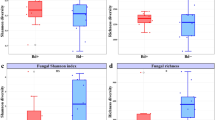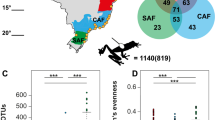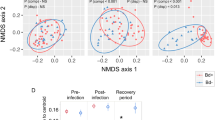Abstract
Symbiotic bacteria on amphibian skin can inhibit growth of the fungus Batrachochytrium dendrobatidis (Bd) that has caused dramatic population declines and extinctions of amphibians in the Neotropics. It remains unclear how the amphibians’ skin microbiota is influenced by environmental bacterial reservoirs, host-associated factors such as susceptibility to pathogens, and pathogen presence in tropical amphibians. We sampled skin bacteria from five co-occurring frog species that differ in Bd susceptibility at one Bd-naive site, and sampled one of the non-susceptible species from Bd-endemic and Bd-naive sites in Panama. We hypothesized that skin bacterial communities (1) would be distinct from the surrounding environment regardless of the host habitat, (2) would differ between Bd susceptible and non-susceptible species and (3) would differ on hosts in Bd-naive and Bd-endemic sites. We found that skin bacterial communities were enriched in bacterial taxa that had low relative abundances in the environment. Non-susceptible species had very similar skin bacterial communities that were enriched in particular taxa such as the genera Pseudomonas and Acinetobacter. Bacterial communities of Craugastor fitzingeri in Bd-endemic sites were less diverse than in the naive site, and differences in community structure across sites were explained by changes in relative abundance of specific bacterial taxa. Our results indicate that skin microbial structure was associated with host susceptibility to Bd and might be associated to the history of Bd presence at different sites.
Similar content being viewed by others

Log in or create a free account to read this content
Gain free access to this article, as well as selected content from this journal and more on nature.com
or
References
Antwis RE, Haworth RL, Engelmoer DJP, Ogilvy V, Fidgett AL, Preziosi RF . (2014). Ex situ diet influences the bacterial community associated with the skin of red-eyed tree frogs (Agalychnis callidryas. PLoS One 9: 1–8.
Becker MH, Harris RN . (2010). Cutaneous bacteria of the redback salamander prevent morbidity associated with a lethal disease. PLoS One 5: e10957.
Becker MH, Richards-Zawacki CL, Gratwicke B, Belden LK . (2014). The effect of captivity on the cutaneous bacterial community of the critically endangered Panamanian golden frog (Atelopus zeteki. Biol Conserv 176: 199–206.
Becker MH, Walke JB, Murrill L, Woodhams DC, Reinert LK, Rollins-Smith LA et al. (2015a). Phylogenetic distribution of symbiotic bacteria from Panamanian amphibians that inhibit growth of the lethal fungal pathogen Batrachochytrium dendrobatidis. Mol Ecol 24: 1628–1641.
Becker MH, Walke JB, Cikanek S, Savage AE, Mattheus N, Santiago CN et al. (2015b). Composition of symbiotic bacteria predicts survival in Panamanian golden frogs infected with a lethal fungus. Proc R Soc B 282: 20142881.
Belden LK, Hughey MC, Rebollar EA, Umile TP, Stephen C, Burzynski EA et al. (2015). Panamanian frog species host unique skin bacterial communities. Front Microbiol 6: 1171.
Berger L, Speare R, Daszak P, Green DE, Cunningham AA, Goggin CL et al. (1998). Chytridiomycosis causes amphibian mortality associated with population declines in the rain forests of Australia and Central America. Proc Natl Acad Sci USA 95: 9031–9036.
Bokulich NA, Subramanian S, Faith JJ, Gevers D, Gordon I, Knight R et al. (2013). Quality-filtering vastly improves diversity estimates from Illumina amplicon sequencing. Nat Methods 10: 57–59.
Boutilier RG, Stiffler DF, Toews D . (1992) Exchange of respiratory gases, ions and water in amphibious and aquatic amphibians. In: Feder ME, Burggren WW (eds). Environmental Physiology of the Amphibians Chapter 5 University of Chicago Press: Chicago, London, pp 81–124.
Brem FMR, Lips KR . (2008). Batrachochytrium dendrobatidis infection patterns among Panamanian amphibian species, habitats and elevations during epizootic and enzootic stages. Dis Aquat Organ 81: 189–202.
Brucker RM, Baylor CM, Walters RL, Lauer A, Harris RN, Minbiole KPC . (2008a). The identification of 2,4-diacetylphloroglucinol as an antifungal metabolite produced by cutaneous bacteria of the salamander Plethodon cinereus. J Chem Ecol 34: 39–43.
Brucker RM, Harris RN, Schwantes CR, Gallaher TN, Flaherty DC, Lam BA et al. (2008b). Amphibian chemical defense: antifungal metabolites of the microsymbiont Janthinobacterium lividum on the salamander Plethodon cinereus. J Chem Ecol 34: 1422–1429.
Caporaso JG, Kuczynski J, Stombaugh J, Bittinger K, Bushman FD, Costello EK et al. (2010a). QIIME allows analysis of high-throughput community sequencing data. Nat Methods 7: 335–336.
Caporaso JG, Bittinger K, Bushman FD, Desantis TZ, Andersen GL, Knight R . (2010b). PyNAST: a flexible tool for aligning sequences to a template alignment. Bioinformatics 26: 266–267.
Caporaso JG, Lauber CL, Walters WA, Berg-Lyons D, Lozupone CA, Turnbaugh PJ et al. (2011). Global patterns of 16S rRNA diversity at a depth of millions of sequences per sample. Proc Natl Acad Sci USA 108 (Suppl 1): 4516–4522.
Cárdenas A, Rodriguez-R LM, Pizarro V, Cadavid LF, Arévalo-Ferro C . (2012). Shifts in bacterial communities of two Caribbean reef-building coral species affected by white plague disease. ISME J 6: 502–512.
Clemente JC, Pehrsson EC, Blaser MJ, Sandhu K, Gao Z, Wang B et al. (2015). The microbiome of uncontacted Amerindians. Sci Adv 1: e1500183–e1500183.
Clarke KR, Gorley RN . (2006), PRIMER v6: User Manual/Tutorial. PRIMER-E, Plymouth.
Conlon JM . (2011). Structural diversity and species distribution of host-defense peptides in frog skin secretions. Cell Mol Life Sci 68: 2303–2315.
Coughlan MP . (1985). The properties of fungal and bacterial cellulases with comment on their production and application. Biotechnol Genet Eng Rev 3: 39–109.
Crawford AJ, Lips KR, Bermingham E . (2010). Epidemic disease decimates amphibian abundance, species diversity, and evolutionary history in the highlands of central Panama. Proc Natl Acad Sci USA 107: 13777–13782.
Crawford AJ, Cruz C, Griffith E, Ross H, Ibáñez R, Lips KR et al. (2013). DNA barcoding applied to ex situ tropical amphibian conservation programme reveals cryptic diversity in captive populations. Mol Ecol Resour 13: 1005–1018.
Dale C, Moran NA . (2006). Molecular Interactions between bacterial symbionts and their hosts. Cell 126: 453–465.
Drenkard E, Ausubel FM . (2002). Pseudomonas biofilm formation and antibiotic resistance are linked to phenotypic variation. Nature 416: 740–743.
Edgar RC . (2010). Search and clustering orders of magnitude faster than BLAST. Bioinformatics 26: 2460–2461.
Edwards HA . (1979). A novel mechanism for salt and fluid transport across epithelia. J Exp Biol 83: 335–338.
Eren AM, Sogin ML, Morrison HG, Vineis JH, Fisher JC, Newton RJ et al. (2015). A single genus in the gut microbiome reflects host preference and specificity. ISME J 9: 90–100.
Feldhaar H . (2011). Bacterial symbionts as mediators of ecologically important traits of insect hosts. Ecol Entomol 36: 533–543.
Fierer N, Ferrenberg S, Flores GE, González A, Kueneman J, Legg T et al. (2012). From animalcules to an ecosystem: application of ecological concepts to the human microbiome. Annu Rev Ecol Evol Syst 43: 137–155.
Fitzpatrick BM, Allison AL . (2014). Similarity and differentiation between bacteria associated with skin of salamanders (Plethodon jordani and free-living assemblages. FEMS Microbiol Ecol 88: 482–494.
Flechas SV, Sarmiento C, Cárdenas ME, Medina EM, Restrepo S, Amézquita A . (2012). Surviving Chytridiomycosis: differential anti-Batrachochytrium dendrobatidis activity in bacterial isolates from three lowland species of Atelopus. PLoS One 7: e44832.
Franzenburg S, Walter J, Künzel S, Wang J, Baines JF, Bosch TCG et al. (2013). Distinct antimicrobial peptide expression determines host species-specific bacterial associations. Proc Natl Acad Sci USA 110: E3730–E3738.
Fraune S, Augustin R, Anton-Erxleben F, Wittlieb J, Gelhaus C, Klimovich VB et al. (2010). In an early branching metazoan, bacterial colonization of the embryo is controlled by maternal antimicrobial peptides. Proc Natl Acad Sci USA 107: 18067–18072.
Fraune S, Anton-Erxleben F, Augustin R, Franzenburg S, Knop M, Schröder K et al. (2014). Bacteria–bacteria interactions within the microbiota of the ancestral metazoan Hydra contribute to fungal resistance. ISME J 9: 1–14.
Friesen LR, Kuhn RE . (2012). Fluorescent microscopy of viable Batrachochytrium dendrobatidis. J Parasitol 98: 509–512.
Harris RN, James TY, Lauer A, Simon MA, Patel A . (2006). Amphibian pathogen Batrachochytrium dendrobatidis is inhibited by the cutaneous bacteria of amphibian species. Ecohealth 3: 53–56.
Harris RN, Brucker RM, Walke JB, Becker MH, Schwantes CR, Flaherty DC et al. (2009). Skin microbes on frogs prevent morbidity and mortality caused by a lethal skin fungus. ISME J 3: 818–824.
Innerebner G, Knief C, Vorholt JA . (2011). Protection of Arabidopsis thaliana against leaf-pathogenic Pseudomonas syringae by Sphingomonas strains in a controlled model system. Appl Environ Microbiol 77: 3202–3210.
Jani AJ, Briggs CJ . (2014). The pathogen Batrachochytrium dendrobatidis disturbs the frog skin microbiome during a natural epidemic and experimental infection. Proc Natl Acad Sci 111: E5049–E5058.
Khosravi A, Mazmanian SK . (2013). Disruption of the gut microbiome as a risk factor for microbial infections. Curr Opin Microbiol 16: 221–227.
Kitamura E, Myouga H, Kamei Y . (2002). Polysaccharolytic activities of bacterial enzymes that degrade the cell walls of Pythium porphyrae, a causative fungus of red rot disease in Porphyra yezoensis. Fish Sci 68: 436–445.
Knief C, Delmotte N, Chaffron S, Stark M, Innerebner G, Wassmann R et al. (2012). Metaproteogenomic analysis of microbial communities in the phyllosphere and rhizosphere of rice. ISME J 6: 1378–1390.
Kolby JE, Ramirez SD, Berger L, Richards-Hrdlicka KL, Jocque M, Skerratt LF . (2015). Terrestrial dispersal and potential environmental transmission of the amphibian chytrid fungus (Batrachochytrium dendrobatidis. PLoS One 10: e0125386.
Kueneman JG, Parfrey LW, Woodhams DC, Archer HM, Knight R, McKenzie VJ . (2014). The amphibian skin-associated microbiome across species, space and life history stages. Mol Ecol 23: 1238–1250.
Küng D, Bigler L, Davis LR, Gratwicke B, Griffith E, Woodhams DC . (2014). Stability of microbiota facilitated by host immune regulation: Informing probiotic strategies to manage amphibian disease. PLoS One 9: e87101.
La Marca E, Lips KR, Lötters S, Puschendorf R, Ibáñez R, Rueda-Almonacid JV et al. (2005). Catastrophic population declines and extinctions in neotropical harlequin frogs (Bufonidae: Atelopus. Biotropica 37: 190–201.
Lindow SE, Brandl MT . (2003). Microbiology of the phyllosphere. Appl Environ Microbiol 69: 1875–1883.
Lips KR, Brem F, Brenes R, Reeve JD, Alford RA, Voyles J et al. (2006). Emerging infectious disease and the loss of biodiversity in a Neotropical amphibian community. Proc Natl Acad Sci USA 103: 3165–3170.
Longo F, Vuotto C, Donelli G . (2014). Biofilm formation in Acinetobacter baumannii. New Microbiol 37: 119–127.
Loudon AH, Woodhams DC, Parfrey LW, Archer H, Knight R, McKenzie V et al. (2014). Microbial community dynamics and effect of environmental microbial reservoirs on red-backed salamanders (Plethodon cinereus. ISME J 8: 830–840.
McDonald D, Price MN, Goodrich J, Nawrocki EP, DeSantis TZ, Probst A et al. (2012). An improved Greengenes taxonomy with explicit ranks for ecological and evolutionary analyses of bacteria and archaea. ISME J 6: 610–618.
McKenzie VJ, Bowers RM, Fierer N, Knight R, Lauber CL . (2012). Co-habiting amphibian species harbor unique skin bacterial communities in wild populations. ISME J 6: 588–596.
Meyer EA, Cramp RL, Bernal MH, Franklin CE . (2012). Changes in cutaneous microbial abundance with sloughing: Possible implications for infection and disease in amphibians. Dis Aquat Organ 101: 235–242.
Nyholm SV, McFall-Ngai MJ . (2004). The winnowing: establishing the squid-vibrio symbiosis. Nat Rev Microbiol 2: 632–642.
Ogilvie LA, Overall ADJ, Jones BV. (2012). The human-microbe coevolutionary continuum. In: Ogilvie LA, Hirsch PR (eds). Microbial Ecological Theory. Caister Academic Press: Norfolk, pp 25–42..
Oksanen J, Blanchet FG, Kindt R, Legendre P, Minchin PR, O'Hara RB et al. (2015). vegan: Community Ecology Package. R package version 2.2-1. http://CRAN.R-project.org/package=vegan/.
Otani S, Mikaelyan A, Nobre T, Hansen LH, Koné NA, Sørensen SJ et al. (2014). Identifying the core microbial community in the gut of fungus-growing termites. Mol Ecol 23: 4631–4644.
Price MN, Dehal PS, Arkin AP . (2010). FastTree 2-approximately maximum-likelihood trees for large alignments. PLoS One 5: e9490.
Puschendorf R, Bolaños F, Chaves G . (2006). The amphibian chytrid fungus along an altitudinal transect before the first reported declines in Costa Rica. Biol Conserv 132: 136–142.
R Core Team. (2014) R: A Language and Environment for Statistical Computing. R Foundation for Statistical Computing, Vienna, Austria. http://www.R-project.org/.
Rasconi S, Jobard M, Jouve L, Sime-Ngando T . (2009). Use of calcofluor white for detection, identification, and quantification of phytoplanktonic fungal parasites. Appl Environ Microbiol 75: 2545–2553.
Rebollar EA, Hughey MC, Harris RN, Domangue RJ, Medina D, Ibáñez R et al. (2014). The lethal fungus Batrachochytrium dendrobatidis is present in lowland tropical forests of Far Eastern Panamá. PLoS One 9: e95484.
Reguera G, Leschine SB . (2001). Chitin degradation by cellulolytic anaerobes and facultative aerobes from soils and sediments. FEMS Microbiol Lett 204: 367–374.
Rollins-Smith LA . (2009). The role of amphibian antimicrobial peptides in protection of amphibians from pathogens linked to global amphibian declines. Biochim Biophys Acta - Biomembr 1788: 1593–1599.
Rosenberg E, Koren O, Reshef L, Efrony R, Zilber-Rosenberg I . (2007). The role of microorganisms in coral health, disease and evolution. Nat Rev Microbiol 5: 355–362.
Round JL, Mazmanian SK . (2009). The gut microbiome shapes intestinal immune responses during health and disease. Nat Rev Immunol 9: 313–323.
Salzman NH, Hung K, Haribhai D, Chu H, Karlsson J, Amir E et al. (2010). Enteric defensins are essential regulators of intestinal microbial ecology. Nat Rev Immunol 11: 76–82.
Segata N, Izard J, Waldron L, Gevers D, Miropolsky L, Garrett WS et al. (2011). Metagenomic biomarker discovery and explanation. Genome Biol 12: R60.
Silby MW, Winstanley C, Godfrey SA, Levy SB, Jackson RW . (2011). Pseudomonas genomes: diverse and adaptable. FEMS Microbiol Rev 35: 652–680.
Turnbaugh PJ, Ley RE, Hamady M, Fraser-liggett C, Knight R, Gordon JI . (2007). The human microbiome project: exploring the microbial part of ourselves in a changing world. Nature 449: 804–810.
Waksman SA, Lechevalier HA . (1962). The Actinomycetes, vol III. Williams & Wilkins: Baltimore, MD, USA.
Walke JB, Becker MH, Loftus SC, House LL, Cormier G, Jensen RV et al. (2014). Amphibian skin may select for rare environmental microbes. ISME J 8: 1–11.
Wang Q, Garrity GM, Tiedje JM, Cole JR . (2007). Naïve Bayesian classifier for rapid assignment of rRNA sequences into the new bacterial taxonomy. Appl Environ Microbiol 73: 5261–5267.
Wei Q, Ma LZ . (2013). Biofilm matrix and its regulation in Pseudomonas aeruginosa. Int J Mol Sci 14: 20983–21005.
Wells KD . (2007) The ecology and behavior of amphibians. University of Chicago Press: Chicago, IL.
Woodhams DC, Voyles J, Lips KR, Carey C, Rollins-Smith LA . (2006). Predicted disease susceptibility in a Panamanian amphibian assemblage based on skin peptide defenses. J Wildl Dis 42: 207–218.
Woodhams DC, Vredenburg VT, Simon MA, Billheimer D, Shakhtour B, Shyr Y et al. (2007). Symbiotic bacteria contribute to innate immune defenses of the threatened mountain yellow-legged frog, Rana muscosa. Biol Conserv 138: 390–398.
Woodhams DC, Kilburn VL, Reinert LK, Voyles J, Medina D, Ibáñez R et al. (2008). Chytridiomycosis and amphibian population declines continue to spread eastward in Panama. Ecohealth 5: 268–274.
Woodhams DC, Alford RA, Antwis RE, Archer H, Becker MH, Belden LK et al. (2015). Antifungal isolates database of amphibian skin-associated bacteria and function against emerging fungal pathogens. Ecology 96: 595–595.
Acknowledgements
We thank guides Gustavo, Alonzo and Evelio for assistance in the field. We thank M Bletz for technical assistance in the laboratory and S Ramirez-Barahona for constructive comments to the manuscript. Scientific collection permits were provided by the Panamanian authorities (Autoridad Nacional del Ambiente): permits SE/A-47-12, SEX/A-65-12, SEX/A-77-12 and SEX/A-89-12. Animal care protocols were approved by the Smithsonian Tropical Research Institute’s Animal Care Committee: protocol 2011-1110-2014 and by Virginia Tech’s Animal Care Committee: protocol 11-105- BIOL. This project was supported by the National Science Foundation Grants: DEB-1136602 (to RNH) and DEB-1136640 (LSB).
Author information
Authors and Affiliations
Corresponding author
Ethics declarations
Competing interests
The authors declare no conflict of interest.
Additional information
Supplementary Information accompanies this paper on The ISME Journal website
Supplementary information
Rights and permissions
About this article
Cite this article
Rebollar, E., Hughey, M., Medina, D. et al. Skin bacterial diversity of Panamanian frogs is associated with host susceptibility and presence of Batrachochytrium dendrobatidis. ISME J 10, 1682–1695 (2016). https://doi.org/10.1038/ismej.2015.234
Received:
Revised:
Accepted:
Published:
Issue date:
DOI: https://doi.org/10.1038/ismej.2015.234
This article is cited by
-
First Report of Culturable Skin Bacteria in Melanophryniscus admirabilis (Admirable Redbelly Toad)
Microbial Ecology (2023)
-
Signatures of functional bacteriome structure in a tropical direct-developing amphibian species
Animal Microbiome (2022)
-
Microbiome function predicts amphibian chytridiomycosis disease dynamics
Microbiome (2022)
-
Comparative Analysis of Skin Bacterial Diversity and Its Potential Antifungal Function Between Desert and Pine Forest Populations of Boreal Toads Anaxyrus boreas
Microbial Ecology (2022)
-
Habitat Disturbance Linked with Host Microbiome Dispersion and Bd Dynamics in Temperate Amphibians
Microbial Ecology (2022)


